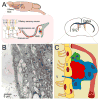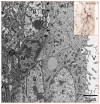Immunological regulation of neurogenic niches in the adult brain
- PMID: 22986164
- PMCID: PMC3490038
- DOI: 10.1016/j.neuroscience.2012.08.053
Immunological regulation of neurogenic niches in the adult brain
Abstract
In mammals, neurogenesis and oligodendrogenesis are germinal processes that occur in the adult brain throughout life. The subventricular zone (SVZ) and subgranular zone (SGZ) are the main neurogenic regions in the adult brain. Therein, resides a subpopulation of astrocytes that act as neural stem cells (NSCs). Increasing evidence indicates that pro-inflammatory and other immunological mediators are important regulators of neural precursors into the SVZ and the SGZ. There are a number of inflammatory cytokines that regulate the function of NSCs. Some of the most studied include: interleukin-1, interleukin-6, tumor necrosis factor alpha, insulin-like growth factor-1, growth-regulated oncogene-alpha, leukemia inhibitory factor, cardiotrophin-1, ciliary neurotrophic factor, interferon-gamma, monocyte chemotactic protein-1 and macrophage inflammatory protein-1alpha. This plethora of immunological mediators can control the migration, proliferation, quiescence, cell-fate choices and survival of NSCs and their progeny. Thus, systemic or local inflammatory processes represent important regulators of germinal niches in the adult brain. In this review, we summarized the current evidence regarding the effects of pro-inflammatory cytokines involved in the regulation of adult NSCs under in vitro and in vivo conditions. Additionally, we described the role of proinflammatory cytokines in neurodegenerative diseases and some therapeutical approaches for the immunomodulation of neural progenitor cells.
Copyright © 2012 IBRO. Published by Elsevier Ltd. All rights reserved.
Figures




Similar articles
-
Immune system modulates the function of adult neural stem cells.Curr Immunol Rev. 2010 Aug 1;6(3):167-173. doi: 10.2174/157339510791823772. Curr Immunol Rev. 2010. PMID: 21037937 Free PMC article.
-
The vasculature of neurogenic niches: Properties and function.Cells Dev. 2023 Jun;174:203841. doi: 10.1016/j.cdev.2023.203841. Epub 2023 Apr 14. Cells Dev. 2023. PMID: 37060947 Review.
-
Nanomedicine boosts neurogenesis: new strategies for brain repair.Integr Biol (Camb). 2012 Sep;4(9):973-81. doi: 10.1039/c2ib20129a. Epub 2012 Jul 17. Integr Biol (Camb). 2012. PMID: 22801448 Review.
-
Immunological control of adult neural stem cells.J Stem Cells. 2010;5(1):23-31. J Stem Cells. 2010. PMID: 20861925 Free PMC article. Review.
-
Immunopharmacological intervention for successful neural stem cell therapy: New perspectives in CNS neurogenesis and repair.Pharmacol Ther. 2014 Jan;141(1):21-31. doi: 10.1016/j.pharmthera.2013.08.001. Epub 2013 Aug 15. Pharmacol Ther. 2014. PMID: 23954656 Review.
Cited by
-
Interactions Between Neural Progenitor Cells and Microglia in the Subventricular Zone: Physiological Implications in the Neurogenic Niche and After Implantation in the Injured Brain.Front Cell Neurosci. 2018 Aug 20;12:268. doi: 10.3389/fncel.2018.00268. eCollection 2018. Front Cell Neurosci. 2018. PMID: 30177874 Free PMC article. Review.
-
Activated CD8+ T lymphocytes inhibit neural stem/progenitor cell proliferation: role of interferon-gamma.PLoS One. 2014 Aug 18;9(8):e105219. doi: 10.1371/journal.pone.0105219. eCollection 2014. PLoS One. 2014. PMID: 25133679 Free PMC article.
-
Central nervous system niche involvement in the leukemia.Clin Transl Oncol. 2016 Mar;18(3):240-50. doi: 10.1007/s12094-015-1370-3. Epub 2015 Aug 5. Clin Transl Oncol. 2016. PMID: 26243400 Review.
-
Erythropoietin protects the subventricular zone and inhibits reactive astrogliosis in kaolin-induced hydrocephalic rats.Childs Nerv Syst. 2019 Mar;35(3):469-476. doi: 10.1007/s00381-019-04063-w. Epub 2019 Jan 19. Childs Nerv Syst. 2019. PMID: 30661113
-
Sex and Age Effects on Neurobehavioral Toxicity Induced by Binge Alcohol.Brain Plast. 2020 Dec 29;6(1):5-25. doi: 10.3233/BPL-190094. Brain Plast. 2020. PMID: 33680843 Free PMC article. Review.
References
-
- Aguirre A, Dupree JL, Mangin JM, Gallo V. A functional role for EGFR signaling in myelination and remyelination. Nat Neurosci. 2007;10:990–1002. - PubMed
-
- Ajmone-Cat MA, Cacci E, Ragazzoni Y, Minghetti L, Biagioni S. Pro-gliogenic effect of IL-1alpha in the differentiation of embryonic neural precursor cells in vitro. J Neurochem. 2010;113:1060–1072. - PubMed
-
- Akiyama S, Yonezawa T, Kudo TA, Li MG, Wang H, Ito M, Yoshioka K, Ninomiya-Tsuji J, Matsumoto K, Kanamaru R, Tamura S, Kobayashi T. Activation mechanism of c-Jun amino-terminal kinase in the course of neural differentiation of P19 embryonic carcinoma cells. J Biol Chem. 2004;279:36616–36620. - PubMed
Publication types
MeSH terms
Substances
Grants and funding
LinkOut - more resources
Full Text Sources
Research Materials

